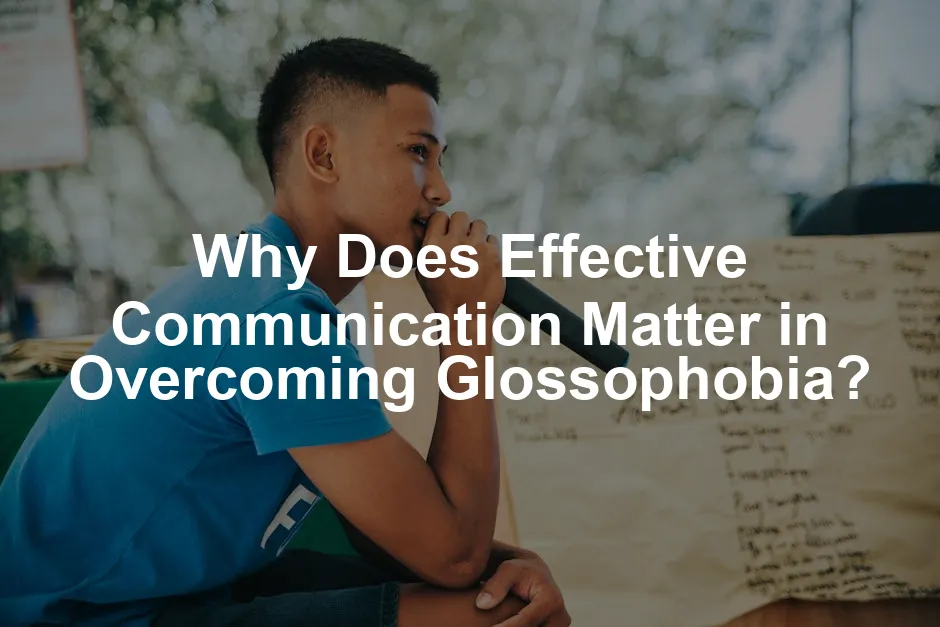
Why Does Effective Communication Matter in Overcoming Glossophobia?
Introduction
Glossophobia, commonly known as the fear of public speaking, affects over 75% of people. It’s a staggering statistic that reveals just how many individuals dread speaking in front of others. This fear can range from mild anxiety to a full-blown panic attack, causing many to avoid vital opportunities in personal and professional contexts. Imagine missing out on that dream job or an important promotion simply because you couldn’t muster the courage to present your ideas.
Effective communication transforms this fear into a powerful tool. It’s not just about delivering a speech; it’s about connecting, engaging, and inspiring your audience. Mastering communication techniques can help individuals channel their nervous energy into confidence, allowing them to express their thoughts clearly and effectively. By honing these skills, people can overcome glossophobia and unlock their full potential, paving the way for success in various aspects of life.
Speaking of honing skills, why not jot down your thoughts and reflections in a Mindfulness Journal? This can help you track your progress and thoughts as you work through your fear of public speaking.
In this blog post, we’ll dive deep into why effective communication is essential in conquering glossophobia. We’ll discuss how understanding your audience, improving verbal and non-verbal skills, and thorough preparation play crucial roles. Ultimately, mastering these skills will empower individuals to face their fears and thrive when speaking in public.

Summary of Key Points
Effective communication serves as a crucial ally in the fight against glossophobia. Understanding the psychological roots of this fear is vital. Many individuals suffer from anxiety due to previous negative experiences or the fear of judgment. However, effective communication helps mitigate these feelings by facilitating a connection with the audience.
Understanding your audience is paramount. When speakers tailor their messages to the audience’s knowledge and interests, they can engage listeners more effectively. This connection fosters a supportive environment, easing anxiety and enhancing confidence.
Additionally, honing verbal and non-verbal communication skills plays a significant role in combating glossophobia. Clear articulation, an appropriate tone, and confident body language can transform a speaker’s presence. Practicing these skills allows individuals to feel more at ease, reducing anxiety during presentations.
If you’re looking for a fun way to practice your skills, consider the Public Speaking Card Game. It’s a playful way to boost your skills while having a good time with friends!
Preparation is another key to overcoming public speaking anxiety. Structuring presentations, rehearsing, and anticipating audience questions can alleviate fear. Cognitive-behavioral techniques can also help reshape negative thought patterns, making public speaking less daunting.
By emphasizing the power of effective communication, we aim to inspire individuals to confront their fears. The journey to overcoming glossophobia may be challenging, but the rewards—personal growth, professional success, and the ability to inspire others—make it worthwhile.

The Essence of Glossophobia
What is Glossophobia?
Glossophobia, the fear of public speaking, affects about 75% of people. This common anxiety can range from mild nerves to overwhelming dread. For many, just the thought of speaking in front of an audience triggers panic. It’s no surprise that public speaking often ranks above death as one of our biggest fears.
When glossophobia strikes, it brings a whirlwind of emotional and physical symptoms. The most common emotional reactions include intense anxiety, dread, and a sense of impending doom. Physically, individuals may experience trembling, sweating, rapid heartbeat, and even nausea. These symptoms can be so intense that they might prompt a desire to flee the situation entirely.
Several psychological factors contribute to glossophobia. Fear of judgment looms large. Many worry about being critiqued or embarrassed by their audience. This fear can stem from past negative experiences, such as being laughed at in school or receiving harsh feedback. Such memories can linger and create a cycle of anxiety that makes public speaking feel like a monumental task.
Additionally, cognitive distortions play a role. Individuals may exaggerate the potential consequences of making a mistake, thinking that a single slip-up could lead to complete humiliation. This catastrophic thinking fuels their anxiety. Moreover, perfectionism often exacerbates the problem. Those with glossophobia may feel they need to deliver a flawless performance, which only intensifies their fear of failure.
Ultimately, understanding glossophobia is crucial for overcoming it. Recognizing the emotional and physical symptoms, along with the psychological factors involved, is a vital first step. By addressing these aspects, individuals can begin to reclaim their confidence and tackle their fears head-on.

The Importance of Effective Communication
Effective communication is a game changer, especially for those grappling with glossophobia. Mastering this skill can have a profound impact on both personal and professional success. In a world where ideas are shared every second, being able to express oneself clearly is invaluable.
Consider the academic setting. Students often face presentations and group discussions. Those who communicate effectively tend to engage their peers better and achieve higher grades. The ability to articulate thoughts can make all the difference in how an idea is received.
In the professional realm, strong communication skills can open doors to career advancement. Presenting ideas persuasively during meetings can lead to promotions and new opportunities. Employers value individuals who can convey messages clearly and inspire teams. This effectiveness translates into leadership roles where communication is key.
For those who want to refine their skills further, consider checking out the Public Speaking for Dummies Book. It’s packed with tips and tricks to help you shine on stage!
Social interactions also benefit greatly from effective communication. Engaging conversations can enhance relationships, foster connections, and build networks. The ability to share ideas and listen actively creates a more harmonious environment, both socially and professionally.
Moreover, effective communication is linked to increased confidence. When individuals feel equipped to express themselves, their self-esteem rises. This newfound confidence can significantly reduce the anxiety associated with public speaking. Instead of viewing the audience as critics, speakers can see them as collaborators eager to hear their message.
Ultimately, honing communication skills is not just about overcoming glossophobia; it’s about unlocking potential. Whether in academia, the workplace, or social settings, effective communication is a bridge to success. By mastering this skill, individuals can transform their fear into a powerful tool, paving the way for greater achievements in all aspects of life.

Effective communication is vital in addressing glossophobia. You can explore more about this fear in detail in this article about glossophobia.
Strategies to Overcome Glossophobia through Effective Communication
Understanding Your Audience
Knowing your audience is vital for effective communication. When you tailor your message to their interests and knowledge, you create a connection. This connection eases anxiety and fosters engagement. Imagine standing in front of a crowd, and instead of seeing a sea of judgmental faces, you see eager listeners. That’s the power of understanding your audience!
Start by researching your audience. Who are they? What do they care about? Are they industry experts or complete novices? Understanding these dynamics allows you to customize your message. Use surveys, social media, or even casual conversations to gather information. This knowledge helps you speak their language.
Next, consider audience demographics. Age, profession, and cultural background can influence how your message is received. For instance, a technical presentation to engineers will differ significantly from a talk to high school students. Adjust your tone and jargon accordingly.
Engage your audience early. Start with a question or a relatable anecdote. This draws them in and helps you gauge their reactions. As you speak, keep an eye on their body language. Are they nodding along, or do they seem confused? Use this feedback to adjust your delivery on the fly.
Finally, remember to invite interaction. Encourage questions and discussions. This not only builds rapport but also transforms a monologue into a conversation. When your audience feels involved, they’re more likely to connect with your message, and you’ll feel more at ease. So, get to know your audience and watch your confidence soar!

Mastering Verbal and Non-Verbal Communication Skills
Effective communication combines verbal and non-verbal skills. Let’s break them down. First, focus on verbal communication. Clarity is key. Speak clearly and at a moderate pace. This gives your audience time to absorb your message. Use a tone that matches your content. If you’re sharing exciting news, let that excitement show!
Pacing matters too. Too fast? Your audience may miss vital points. Too slow? They might zone out. Practice varying your speed for emphasis. Use pauses effectively. They can build suspense or give your audience a moment to think.
Now, let’s shift to non-verbal communication. Body language communicates volumes! Stand tall, maintain eye contact, and use open gestures. This exudes confidence and helps you connect with your audience. Avoid crossing your arms or fidgeting; these actions can signal insecurity.
Eye contact is crucial. It builds trust and keeps your audience engaged. Try to make eye contact with different sections of the audience throughout your presentation. This creates a sense of connection, making it feel more like a conversation than a performance.
Gestures enhance your message. Use them to emphasize points or illustrate concepts. However, ensure your gestures are natural and not overdone. Practice in front of a mirror or record yourself to perfect your delivery.
To hone these skills, engage in exercises. Practice speaking in front of friends or family. Ask for feedback on your clarity, tone, and body language. Join clubs like Toastmasters International Membership Manual for more structured opportunities. Remember, mastering verbal and non-verbal skills transforms your communication and helps you conquer glossophobia!

Preparing and Structuring Your Presentation
Effective speech preparation is like building a sturdy foundation. Without it, your message might crumble under pressure. So, how do we construct this solid base? Start by outlining key points. Write down your main ideas, supporting arguments, and examples. This step not only organizes your thoughts but also helps you understand the flow of your presentation.
Next, practice your delivery. Rehearsing in front of a mirror or recording yourself can reveal areas for improvement. It’s like having a personal coach! You’ll notice if you mumble or if your body language screams “nervous.” Practice until you feel like a pro, not a deer caught in headlights.
Now, let’s talk about the magic of visual aids. Slides, charts, or even props can add flair to your presentation. They keep your audience engaged and help illustrate your points. Just remember: visuals should enhance your message, not overwhelm it. Use images, not walls of text, and maintain a clean, professional design.
Storytelling is another powerful tool. Wish you could draw people in? Share a personal anecdote or a relevant story. Humans connect with stories; they evoke emotions and make your message memorable. When you share your experiences, you create a bridge between you and your audience—turning listeners into participants.
If you’re looking to boost your presentation skills even further, consider a Professional Presentation Software. It can help you create stunning visuals that captivate your audience!
Lastly, adapt your presentation for your audience. Know who they are and what they care about. Tailoring your message ensures it resonates with them. Remember, effective communication isn’t just about what you say; it’s about how your audience receives it. So prepare, practice, and present with confidence!

Utilizing Mindfulness and Relaxation Techniques
Mindfulness is your secret weapon against glossophobia. It’s all about being present, reducing anxiety, and focusing on the moment. Before stepping onto the stage, take a few minutes to practice mindfulness. Find a quiet space, close your eyes, and center yourself. Focus on your breathing—inhale deeply through your nose and exhale slowly through your mouth. This simple technique calms your mind and body, setting a positive tone for your speech.
Breathing exercises are also fantastic for easing pre-speech jitters. They help regulate your heart rate and combat that pesky fight-or-flight response. Try the 4-7-8 technique: inhale for four seconds, hold for seven, and exhale for eight. It’s like a mini-vacation for your mind! You’ll notice a difference in how you feel when it’s time to present.
For those seeking extra relaxation, a Essential Oil Diffuser for Relaxation can create a calming environment to help ease your nerves.
Visualization techniques can work wonders too. Picture yourself standing confidently in front of the audience, delivering your message with ease. Visualize the audience nodding and applauding. This positive imagery can help reshape your mindset. Rather than imagining failure, you’ll focus on success, boosting your confidence.
Incorporating these mindfulness practices into your routine can significantly reduce anxiety. The more you practice, the more comfortable you’ll feel in any speaking situation. Remember, public speaking is a skill, and like any skill, it improves with practice. Embrace mindfulness, and you’ll find the confidence to conquer glossophobia!

Conclusion
Effective communication is not just a tool; it’s a superpower! For those grappling with glossophobia, it can be the key to unlocking a world of opportunities. Understanding the roots of this fear is crucial. Once individuals grasp why they feel anxious, they can implement strategies to enhance their communication skills. With practice, anyone can turn anxiety into confidence.
The journey to becoming a great speaker may be long and winding, but the rewards are bountiful. Imagine the personal growth you’ll experience, the career advancements that follow, and the ability to inspire others with your words. Public speaking isn’t just about sharing information; it’s about connecting with others and making an impact.
So, why wait? Embrace the power of communication. Take that first step toward conquering glossophobia today. With every speech, every presentation, you’ll grow stronger, more confident, and ready to take on the world. Your voice matters, and it’s time to let it shine!

FAQs
What is glossophobia?
Glossophobia is the fear of public speaking. It affects about 75% of people, causing anxiety and discomfort when speaking in front of an audience.
How can I overcome glossophobia?
Start by understanding your fear and practicing regularly. Strategies include gradually exposing yourself to speaking situations, honing your communication skills, and seeking support from peers or clubs like Toastmasters.
Is it common to feel nervous before speaking?
Absolutely! Feeling nervous is a natural response. Many people experience pre-speech jitters, but with practice and preparation, these feelings can be managed effectively.
What resources are available for improving public speaking skills?
Consider workshops, online courses, and community groups like Toastmasters. These resources offer valuable practice and feedback in a supportive environment, helping you build confidence and refine your speaking skills.
Please let us know what you think about our content by leaving a comment down below!
Thank you for reading till here 🙂
All images from Pexels




